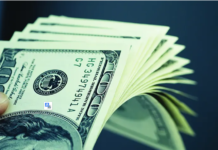
A file photo shows a man counting Tk 1,000 notes in the capital. The private sector credit growth declined to 9.2 per cent in January amid heavy government borrowing from the banking sector and the government’s move to cut lending rate for banks to 9 per cent.— New Age photo
The private sector credit growth declined to 9.2 per cent in January amid heavy government borrowing from the banking sector and the government’s move to cut lending rate for banks to 9 per cent.
The private sector credit growth in all the seven months of the fiscal year 2019-2020 remained far below the Bangladesh Bank’s projection of 14.8 per cent growth for FY20.
Bankers and experts said that the constant fall in private sector credit growth would ultimately slow down the country’s economy.
If the circumstances remain unchanged, the credit situation to the businesses would deteriorate further in the coming days, they cautioned.
The private sector credit growth in January was the lowest after 2008 when the growth rate tumbled below 9 per cent.
Banks’ outstanding loans to the private sector stood at Tk 10,52,473 crore at the end of January.
In December last year, the growth rate dropped to 9.83 per cent from 9.87 per cent in the previous month.
Former adviser to an interim government AB Mirza Azizul Islam told New Age, ‘It [the fall in private sector credit growth] indicates that the investors have refrained themselves from taking loans.’
A fall in deposit growth amid the government’s move to implement 9 per cent lending rate and 6 per cent deposit rate is leading the banking sector to a liquidity crisis and thus resulted in a lower credit flow to the businesses, Mirza Aziz said.
Asked whether the private sector credit growth would be enough to attain economic expansion that the government has focused to achieve, the economist said, ‘It would not be possible.’
He said that if the growth rate continued to deteriorate, it would not be possible for the government to attain the double digit growth of the country’s economy that the government had been speaking about.
Besides, bankers said that the businesses might have adopted a go-slow approach amid talks on enforcing 9 per cent lending rate from April 1 this year.
On February 24, the Bangladesh Bank set the upper ceiling on banks’ lending rate at 9 per cent, setting April 1 as the effective date. The BB on Monday asked banks to implement immediately the lending rate against import financing of nine essential commodities ahead of Ramadan.
As the reduced rate would be a great respite for the businesses, they were waiting for its implementation, bankers said.
As per the BB’s circular, all the existing and fresh loans would come under the BB’s circular on lending rate.
The government’s heavy borrowing from the sector was another reason for the continued sharp fall in private sector credit growth, Policy Research Institute executive director Ahsan H Mansur told New Age.
The government’s borrowing from the banking sector exceeded its budgetary projection in seven months of FY20 and is expected to increase further due to dismal growth in revenue collection.
‘Why would the banks be willing to go for private sector lending when the government is offering more than 9 per cent interest?’ Mansur questioned.
‘The banks are not irresponsible and they know the level of risk in lending to the government and lending to the private sector,’ he said.
There is no risk when the banks lend to the government whereas each lending to the private sector creates some risk for the banks, he said.
Deposit growth has been unimpressive in recent times and that has resulted in the fall in private sector credit growth, he said.
The private sector lending would fall further once the 9 per cent lending rate and 6 per cent deposit rate come into effect, the economist said.
As a result, the enforcement of the lending rate would bring any positive outcome neither for the government nor for the banks, he said.
He also cautioned that the private sector credit growth might decline further.









